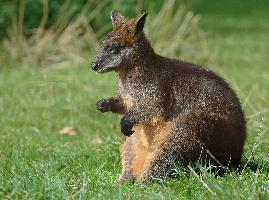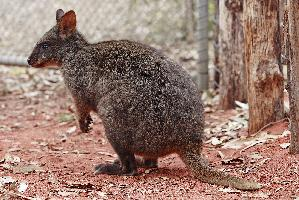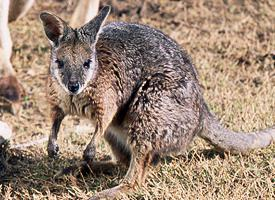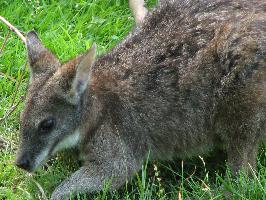
Popis zvířete
The Swamp Wallaby, scientifically known as Wallabia bicolor, is a small to medium-sized marsupial native to the eastern regions of Australia. This unique animal exhibits a fascinating blend of physical and behavioral traits that distinguish it from other wallabies and kangaroos.Physical Characteristics:
The Swamp Wallaby has a robust and stocky build with a body length ranging from 65 to 85 centimeters and a tail that is often as long or longer than the body, adding another 70 to 85 centimeters in length. This species exhibits sexual dimorphism, with males generally larger and more muscular than females. One of the most striking features of the Swamp Wallaby is its coat color, which varies from dark brown to black, often with lighter patches on the chest, belly, and cheeks. The fur is coarse and thick, providing insulation and protection from the dense underbrush of its habitat.
The Swamp Wallaby's powerful hind legs are built for agility and strength, enabling it to navigate through dense vegetation and leap great distances. Its forelimbs are shorter and equipped with sharp claws, useful for foraging and feeding. Another distinctive feature is its long, bushy tail, which aids in balance and is often carried in a characteristic curled position when the animal is at rest.
Habitat and Distribution:
Swamp Wallabies are predominantly found in the eastern parts of Australia, ranging from the northern regions of Queensland down to Victoria and southeastern South Australia. They thrive in a variety of habitats, including dense forests, woodlands, and heathlands, often near swamps, hence their name. Unlike many other wallaby species, Swamp Wallabies are solitary animals and have a strong preference for thick underbrush where they can hide from predators and forage for food.
Diet and Feeding Behavior:
The diet of the Swamp Wallaby is quite varied and includes a mix of leaves, ferns, flowers, and occasionally fruits and seeds. They are known to be one of the few mammalian species capable of digesting a wide range of plants, including some that are toxic to other animals. This adaptability allows them to survive in environments with limited food sources. Swamp Wallabies are primarily nocturnal and crepuscular, feeding mainly at night or during the twilight hours.
Reproduction and Lifecycle:
Swamp Wallabies have a unique reproductive system called embryonic diapause, which allows the female to delay the development of an embryo until conditions are favorable. After a gestation period of about 33 to 38 days, the female gives birth to a single joey, which then crawls into its mother's pouch to continue developing. The joey remains in the pouch for about 8 to 9 months before gradually starting to explore the outside world. However, it may continue to nurse and return to the pouch for safety until it is about 15 months old.
Conservation Status:
Currently, the Swamp Wallaby is classified as Least Concern by the International Union for Conservation of Nature (IUCN), indicating that it is not currently at risk of extinction. However, they do face threats from habitat destruction, vehicle collisions, and predation by introduced species such as foxes and feral dogs. Conservation efforts are focused on habitat preservation and the management of predator populations to ensure the continued survival of this unique marsupial.
In summary, the Swamp Wallaby is a fascinating and adaptable marsupial with a distinctive appearance and unique behavioral traits. Its ability to thrive in a variety of habitats and consume a diverse diet has enabled it to persist in a changing landscape, making it an integral part of Australia's natural heritage.
Podobná zvířata
Nové fotografie zvířat
Top 10 zvířat
- Elephant hawk moth (Deilephila elpenor)
- Common house mosquito (Culex pipiens)
- Australian box jelly (Chironex fleckeri)
- Fruit fly (Drosophila melanogaster)
- Wasp spider (Argiope bruennichi)
- Bee hummingbird (Mellisuga helenae)
- Colossal squid (Mesonychoteuthis hamiltoni)
- Waitaha penguin (Megadyptes waitaha)
- Common cockchafer (Melolontha melolontha)
- European hornet (Vespa crabro)


